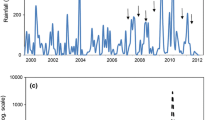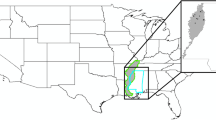Abstract
In annually flooded and dewatered mudflats, does the big flush of germination following dewatering exhaust the seed bank, and if not, how long can seeds remain viable and nongerminated under annual flooding cycles? Soil samples from mudflats in Land Between the Lakes in western Kentucky and northwestern central Tennessee (USA) were collected in 1990, 1991, and 1992 and annually flooded in winter and kept moist during summer for 15, 14, and 13 years, respectively. Beginning in 1996, all samples were stirred when dewatered in June. Seedlings were counted and removed, thus preventing any input of new seeds. During the study, seeds of 37 species germinated, and there were 2 to 8588 seedlings m−2, depending on the species. Ten of the species germinated in only one set of samples (2–4 seedlings m−2) in 1 year, but the number of years before germination ranged from 1 to 9; one species germinated in two sets of samples (2–4 seedlings m−2) after 6 and 9 years. Eighteen species germinated in 2–12 of the years but not necessarily in consecutive years. Eight species germinated in 14 and/or 15 years. Regardless of seed bank size, seeds of many species lived in the samples for extended periods of time with 31 (83.8%) germinating after ≥ 5 years and 19 (48.6%) after ≥ 10 years. New species appeared in the 1990, 1991, and 1992 samples after 8, 9, and 11 years, respectively. Thus, if the seedling emergence method is used to study mudflat soil seed banks and monitoring is terminated after only a relative short period of time, the size and species richness of the seed bank may be greatly underestimated.



Similar content being viewed by others
References
Amaranthus website. https://www.inspection.gc.ca/plants/seeds/testing-grading/seeds-identification/amaranthus-tuberculatus/eng/1472604808680/1472742385047. Accessed 9 Mar 2019
Baskin CC, Baskin JM, Chester EW (1993a) Germination ecology of Leptochloa panicoides, a summer annual grass of seasonally dewatered mudflats. Acta Oecol 14:693–704
Baskin CC, Baskin JM, Chester EW (1993b) Seed germination ecophysiology of four summer annual mudflat species of Cyperaceae. Aquat Bot 45:41–52
Baskin CC, Baskin JM, Chester EW (1994) Annual dormancy cycle and influence of flooding in buried seeds of mudflat populations of the summer annual Leucospora multifida. Ecoscience 1:47–53
Baskin CC, Baskin JM, Chester EW (2002a) Seed germination ecology of summer annual species of dewatered reservoir shorelines (mudflats), a temporally unpredictable habitat. In: Chester EW, Fraslish JS (eds) Land Between the Lakes, Kentucky and Tennessee: four decades of Tennessee Valley Authority Stewardship. Miscellaneous publication number 16. The Center for Field Biology, Austin Peay State University, Clarksville, pp 353–368
Baskin CC, Baskin JM, Chester EW (2002b) Effects of flooding and temperature on dormancy break in seeds of the summer annual mudflat species Ammannia coccinea and Rotala ramosior (Lythraceae). Wetlands 22:661–668
Baskin CC, Baskin JM, Chester EW (2004) Seed germination ecology of the summer annual Cyperus squarrosus in an unpredictable mudflat habitat. Acta Oecol 26:9–14
Bliss D, Smith H (1985) Penetration of light into soil and its role in the control of seed germination. Plant Cell Environ 8:475–483
Brock MA (2011) Persistence of seed banks in Australian temporary wetlands. Freshw Biol 56:312–327
Chester EW (1992) The vascular flora of Lake Barkley (Lower Cumberland River) seasonally dewatered flats. In: Snyder DH (ed) Proceedings of the contributed papers sessions of the fourth annual symposium on the natural history of lower Tennessee and Cumberland river valleys. The Center for Field Biology, Austin Peay State University, Clarksville, pp 67–79
Cyperus website. https://gobotany.newenglandwild.org/species/cyperus/iria/. Accessed 9 Mar 2019
Gleason HA (1963) The new Britton and Brown illustrated flora of northeastern United States and adjacent Canada. Hafner Publishing Co., Inc, New York
Haukos DA, Smith LM (1994) Composition of seed banks along an elevational gradient in playa wetlands. Wetlands 14:301–307
Howard RJ, Wells CJ (2009) Plant community establishment following drawdown of a reservoir in southern Arkansas, USA. Wetlands Ecol Manag 17:565–583
Keddy PA, Reznicek AA (1982) The role of seed banks in the persistence of Ontario's coastal plain flora. Am J Bot 69:13–22
Klimešová J, Martínková J, Kočarová M (2004) Biological flora of Central Europe: Rorippa palustris (L.) Besse. Flora 199:453–463
Leck MA, Simpson RL (1987) Seed bank of a freshwater tidal wetland: turnover and relationship to vegetation change. Am J Bot 74:360–370
Leck MA, Simpson RL (1994) Tidal freshwater wetland zonation: seed and seedling dynamics. Aquat Bot 47:61–75
Leck MA, Simpson RL (1995) Ten-year seed bank and vegetation dynamics of a tidal freshwater marsh. Am J Bot 82:1547–1557
Martin AC (1946) The comparative internal morphology of seeds. Amer Midl Nat 36:513–660
McGregor RL, Volle LD (1950) First year invasion of plants on the exposed bed of Lake Fegan, Woodson County, Kansas. Trans Kansas Acad Sci 53:372–377
Milberg P, Andersson L, Thompson K (2000) Large-seeded species are less dependent on light for germination than small-seeded ones. Seed Sci Res 10:99–104
Pederson RL (1981) Seed bank characteristics of the Delta Marsh, Montana. In: Richardson B (ed) Selected proceedings of the midwest conference on wetland values and management, 17-19 June 1981, St. Paul, MN. Freshwater Society, Navarre, pp 61–69
Pluchea (2019) https://ucjeps.berkeley.edu/eflora/eflora_display.php?tid=8084. Accessed 9 Mar 2019
Porter JL, Kingsford RT, Brock MA (2007) Seed banks in arid wetlands with contrasting flooding, salinity and turbidity regimes. Plant Ecol 188:215–234
Raffaele E (1996) Relationship between seed and spore banks and vegetation of a mountain flood meadow (mallín) in Patagonia, Argentina. Wetlands 16:1–9
Salisbury EJ (1970) The pioneer vegetation of exposed muds and its biological features. Philos Trans R Soc Lond B 259:207–255
Shipley B, Parent M (1991) Germination responses of 64 wetland species in relation to seed size, minimum time to reproduction and seedling relative growth rate. Funct Ecol 5:111–118
Smith LM, Kadlec JA (1983) Seed banks and their role during drawdown of a North American marsh. J Appl Ecol 20:673–684
The Plant List. www.theplantlist.org. Accessed 22 June 2018
van der Valk AG, Davis CB (1978) The role of seed banks in the vegetation dynamics of prairie glacial marshes. Ecology 59:322–335
van der Valk AG, Davis CB (1979) A reconstruction of the recent vegetational history of a prairie marsh, Eagle Lake, Iowa, from its seed bank. Aquat Bot 6:29–51
Voigtland CW, Poppe WL (1989) The Tennessee river. In: Dodge DP (ed) Proceedings of the international large river symposium. Canadian special publication of fisheries and aquatic sciences, vol 106, pp 372–384
Webb DH, Dennis WM, Bates AL (1988) An analysis of the plant community of mudflats of TVA mainstream reservoirs. In: Snyder DH (ed) Proceedings of the first annual symposium on the natural history of lower Tennessee and Cumberland river valleys. The Center for Field Biology, Austin Peay State University, Clarksville, pp 177–198
White DA (1993) Vascular plant community development on mudflats in the Mississippi River delta, Louisiana, USA. Aquat Bot 45:171–194
Wilson SD, Moore DRJ, Keddy PA (1993) Relationships of marsh seed banks to vegetation patterns along environmental gradients. Freshw Biol 29:361–370
Wisheu IC, Keddy PA (1991) Seed banks of a rare wetland plant community: distribution patterns and effects of human-induced disturbance. J Veg Sci 2:181–188
Author information
Authors and Affiliations
Corresponding author
Additional information
Communicated by Claus Holzapfel.
Publisher's Note
Springer Nature remains neutral with regard to jurisdictional claims in published maps and institutional affiliations.
Rights and permissions
About this article
Cite this article
Baskin, C.C., Baskin, J.M. & Chester, E.W. Long-term persistence of summer annuals in soil seed banks of seasonally dewatered mudflats. Plant Ecol 220, 731–740 (2019). https://doi.org/10.1007/s11258-019-00948-7
Received:
Accepted:
Published:
Issue Date:
DOI: https://doi.org/10.1007/s11258-019-00948-7




